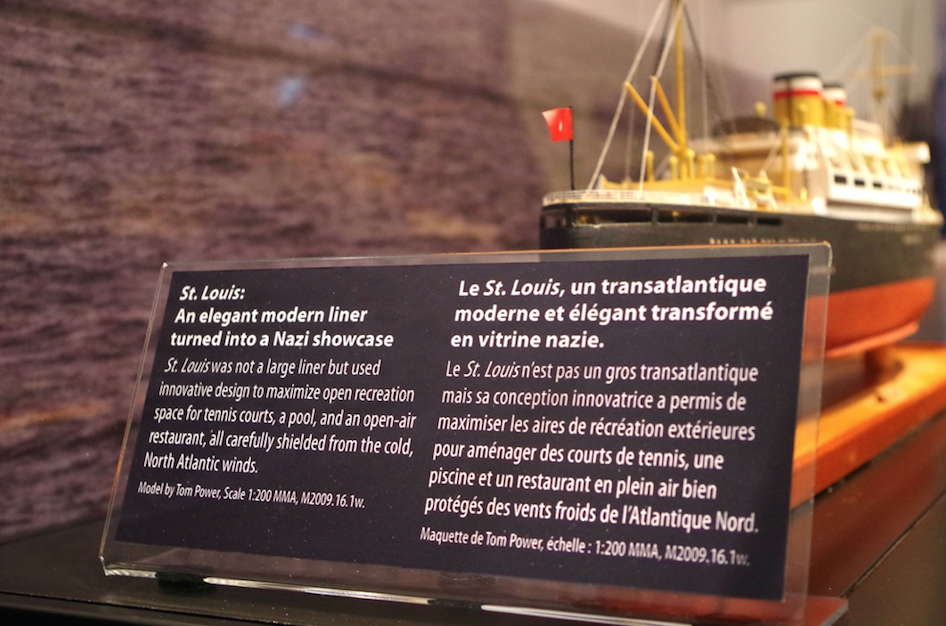War Museum exhibit tells story of refugees turned away from Canada
By Evelyn Myers
A new exhibit at the Canadian War Museum explores the Second World War-era tragedy of the St. Louis, in which more than 900 Jewish refugees fleeing the Nazis aboard a German ocean liner were turned away from Canada, the U.S. and other countries.
Tragically, hundreds of the refugees who were forced to return to Europe perished during the Holocaust.
St. Louis – Ship of Fate is a traveling exhibit from the Maritime Museum of the Atlantic, part of the Nova Scotia Museum. The exhibit features a metre-long model of the ocean liner and includes photographs, texts and interactive audiovisual materials to tell the story of the ill-fated vessel and its passengers.
“We have an image of ourselves as a country that’s always been open and available to the proverbial huddled masses yearning to be free,” said York University historian Irving Abella, co-author of None is Too Many: Canada and the Jews of Europe 1933-1948.
Until the 1960s, Abella noted, Canada had a white-only immigration policy that was very restrictive.
“It’s important for Canadians to know their history, the foundations of our immigration policy — which was built on a foundation of racism at least until the 1960s, for the first hundred years of our existence as a country,” said Abella, who is also president of the Academy of Arts and Humanities of the Royal Society of Canada.
The St. Louis exhibit shows the value of acknowledging the dark moments in Canada’s past so we can look at the future with a better understanding of history, said Yasmine Mingay, the museum’s director of public affairs.
“We hope that this provides visitors of all ages an opportunity to learn about or learn more about this story and this tragic part of our own history — and to keep it in mind moving forward in life,” added Mingay.
In May 1939, Jewish passengers who had been stripped of everything they owned boarded the St. Louis with only an entry visa to Cuba, said Abella. When the ship arrived at Cuba, the government had changed and the passengers were refused entry.
After being turned away from every Latin American country as well as the United States, said Abella, the passengers of the St. Louis approached the shores of Canada — their last chance. But the Canadian government, led at the time by Liberal prime minister Mackenzie King, responded by saying the line must be drawn somewhere, and turned the refugees away, said Abella.
With nowhere else to go, the ship returned to Europe and many of the passengers found refuge in neighbouring European countries, said Gerry Lunn, curator of exhibitions for the MMA. But after the Second World War broke out in September 1939 and Nazi Germany overran much of Europe, more than 250 of the passengers turned away by Canada died in Nazi death camps, noted Lunn.
The MMA produced the travelling exhibit in collaboration with the Atlantic Jewish Council and Immigration, Refugees and Citizenship Canada.

Lunn said the story of the St. Louis is highly relevant in the 21st century.
“Today, particularly with the global refugee crises, so many people, so many millions of people around the world seeking refuge from persecution,” said Lunn, “it’s absolutely essential that we remember these things.”
Unlike other exhibits, this one is light on artifacts and is “modest in size, not in content,” said Lunn.
He said the exhibit was organized with relatively few artifacts so that it could travel to smaller cities and venues hoping to host the display.
The war museum has supplemented the MMA exhibit to add to the visitor experience, noted Mingay, but the format and themes of the original are preserved.
The CMW’s version of the exhibit has been supplemented with large wall graphics, a slideshow of photographs taken during the ship’s crossing to Cuba and back to Europe, and a reading corner with books and transcripts of archival documents, said Mingay.
St. Louis – Ship of Fate will remain at the Canadian War Museum until April 29.

